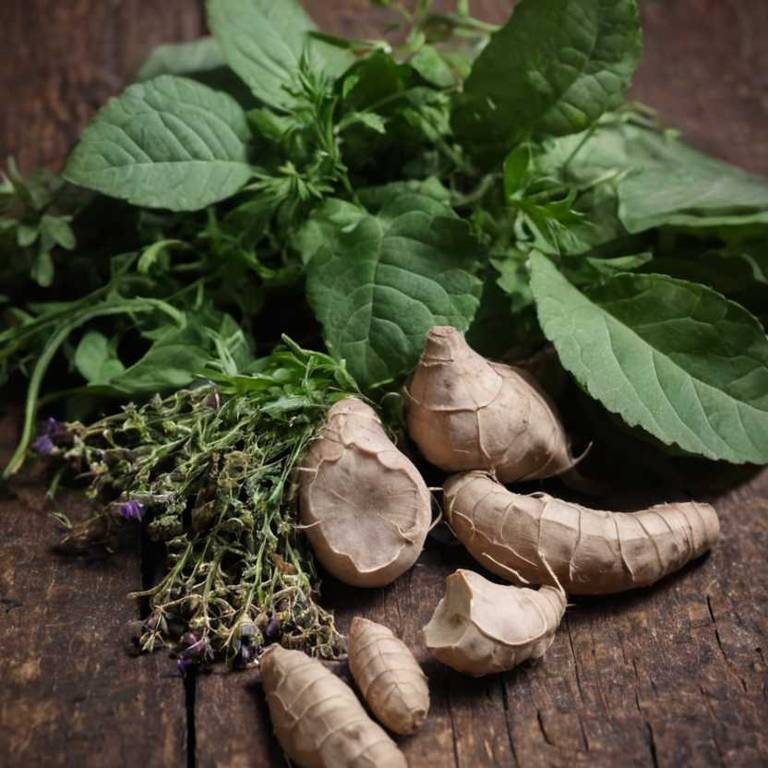By Leen Randell
Updated: Jul 21, 2024
10 Medicinal Constituents Of Pueraria Mirifica (Kwao Krua)

Pueraria mirifica has active constituents such as isoflavones, particularly mirifican, daidzein, and genistein.
These constituents are responsible for the plant's medicinal properties, including anti-inflammatory and antioxidant effects. They can help improve menopausal symptoms, such as hot flashes and night sweats, in women by regulating estrogen levels.
Additionally, the constituents in Pueraria mirifica have been shown to have anti-aging properties, improving skin health and reducing the risk of age-related diseases.
This article explains in details the 10 best active constituents of Pueraria mirifica.
1. Isoflavones
Pueraria mirifica isoflavones is a type of plant-based compound found in the roots of the Pueraria mirifica plant.
These isoflavones are responsible for the plant's estrogenic and hormonal balancing properties, making it popular for traditional medicine in Thailand.
They are believed to mimic the effects of estrogen in the body, promoting healthy hormone levels and alleviating menopausal symptoms such as hot flashes and night sweats.
2. Miroestrol
Pueraria mirifica, also known as Kwao Krua, Miroestrol is a bioactive compound extracted from the roots of the plant Pueraria mirifica.
It has been traditionally used in Thai medicine for its alleged estrogenic and anti-androgenic properties, claiming to improve women's health and reduce symptoms of menopause. Research suggests that miroestrol may exhibit antioxidant, anti-inflammatory, and antimicrobial activities, making it a potential therapeutic agent against various diseases.
Its exact mechanism of action is still being studied, but its potential benefits are promising.
3. Deoxymiroestrol
Pueraria mirifica deoxymiroestrol is a natural compound extracted from the root of this plant.
It has been widely used in traditional Thai medicine for centuries to promote youthfulness and vitality. Deoxymiroestrol is believed to possess estrogenic properties, which may help alleviate menopausal symptoms such as hot flashes and vaginal dryness, as well as improve skin elasticity and hair growth.
Its potential benefits have made it a popular ingredient in many herbal supplements and skincare products.
4. Β-sitosterol
Pueraria mirifica, also known as Kwao Krua, β-sitosterol is a naturally occurring plant sterol extracted from the root of Pueraria mirifica, a Thai vine.
It has been traditionally used in traditional medicine for its potential health benefits, including hormone regulation and anti-inflammatory properties.
Research has shown that β-sitosterol can help to improve symptoms of menopause and polycystic ovary syndrome (PCOS) by reducing inflammation and increasing estrogen levels.
5. Stigmasterol
Pueraria mirifica, also known as Kwao Krua, stigmasterol is a bioactive compound isolated from the plant's tuberous root.
It has been traditionally used in Thai medicine for its potential health benefits, including hormone regulation and anti-aging properties. Stigmasterol has been shown to exhibit estrogenic activity, which may help alleviate menopausal symptoms such as hot flashes and night sweats.
Its antioxidant and anti-inflammatory effects also suggest potential therapeutic applications for various diseases.
6. Daidzein
Pueraria mirifica daidzein is a key active compound found in this traditional Thai herb.
Daidzein has been extensively studied for its potential health benefits, including anti-inflammatory and antioxidant properties. It has also been shown to have estrogenic effects, which may help alleviate menopausal symptoms such as hot flashes and vaginal dryness.
Additionally, daidzein has been linked to improved bone density and cardiovascular health.
7. Genistein
Pueraria mirifica genistein is a key compound found in the plant's tubers.
It is a phytoestrogenic flavonoid that has been extensively studied for its potential health benefits. Genistein has been shown to have antioxidant, anti-inflammatory, and estrogen-like properties, which may help to alleviate menopausal symptoms, improve bone density, and even reduce the risk of certain cancers.
Its unique chemical structure allows it to interact with estrogen receptors in the body, making it a popular ingredient in traditional medicine and modern supplements.
8. Formononetin
Pueraria mirifica formononetin is a bioactive compound extracted from the roots of Pueraria mirifica, a plant native to Thailand.
Formononetin is considered one of the most valuable compounds in Pueraria mirifica, responsible for its numerous health benefits, including anti-inflammatory and antioxidant properties.
It has been traditionally used in Thai medicine for centuries to treat various health conditions, such as menopausal symptoms, osteoporosis, and skin disorders.
9. Biochanin a
Pueraria mirifica biochanin A is a key phytochemical found in the tuber of the plant.
It has been traditionally used in Thai medicine for its potential health benefits, particularly in menopausal symptoms relief and breast enhancement. Biochanin A has been shown to exhibit estrogen-like properties, which may help alleviate hot flashes, night sweats, and vaginal dryness associated with menopause.
Its antioxidant and anti-inflammatory activities may also contribute to its overall therapeutic effects.
10. Kalopanaxatriol
Pueraria mirifica kalopanaxatriol is a bioactive compound extracted from the roots of the Thai medicinal plant Pueraria mirifica.
It has been traditionally used in Ayurvedic and Traditional Chinese Medicine to treat various health conditions, including menopause symptoms, breast enhancement, and hormone imbalance.
Kalopanaxatriol has been shown to possess estrogenic and anti-estrogenic properties, which may help alleviate hot flashes and other menopausal symptoms, as well as improve overall health and wellbeing.